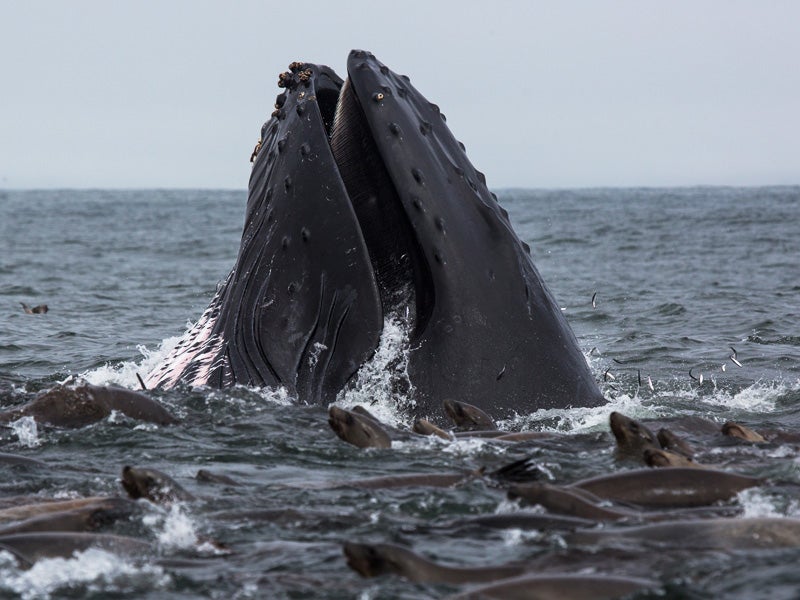To Save the Whales, You Must First Save the Sardines
Sardines are in need of protections like those the menhaden, a similar species, received after their population reached the verge of collapse.

This page was published 10 years ago. Find the latest on Earthjustice’s work.
Menhaden are one of the most important fish you’ve probably never heard of. They are a keystone species, a vital link in the ocean’s food chain.
Four years ago, they were in serious trouble. Overfishing and pollution in the Atlantic Ocean had caused the menhaden population to collapse to its lowest level in 40 years, an alarming fact that reverberated across the entire food chain.
Menhaden are small fish, about 6 to 8 inches in length. They consume algae and serve as a rich, oily food source for bigger fish, including bluefish, striped bass, flounder, swordfish, tuna and whales. The ongoing population decline meant these large predator fish and sea mammals, along with birds that also feast on menhaden, were in trouble, too.
Earthjustice attorneys worked with a coalition of recreational-fishing and ocean-conservation groups and others to help convince the Atlantic States Marine Fisheries Commission that action needed to be taken to stop the decline of the forage fish. In 2012, ASMFC voted to institute the first ever coastwide limits in this fishery, and reduced catch by 25 percent to give the population a chance to recover.
The limits appear to have begun to turn things around. Estimates show that there are about 750 million more menhaden in the water than there would have been without the fishing limits.
Evidence of the impact up the food chain is mostly anecdotal at this early stage, but it is compelling. Whales are once more putting on an exciting display off the coast of New York, feeding on large menhaden schools. Biologists have noted increases of nesting and hunting osprey in the Connecticut River estuary and around Gardiners Island, New York.
Just last month, ASMFC took the next critical step in transforming menhaden management when it agreed to base future management decisions using a reference system that accounts for the status of the ecosystem.
Simply put, that means that decisions about allowable takes won’t be based on what’s necessary to sustain the existing menhaden population; these decisions will take into account what the population needs to be in order to sustain the rest of the ocean ecosystem, keeping counts on all the predators that rely on the fish.
This is a huge step in the right direction, but getting ASMFC to take it wasn’t easy.
The menhaden fishery is mostly exploited by one company: Omega Protein. Its huge fleet of industrial-scale “super-seiners” catch billions of menhaden every year, mostly to grind up for fertilizer, animal feed and fish-oil supplements.
This one company wielded outsized influence on ASMFC and state-level agencies. It took a lot to counter that and convince the ASMFC to take a more science-based approach. Though we faced a formidable corporation that gained some concession in catch, the overall prognosis is very promising.
Future decisions will take into account the needs of all sorts of fish, birds and whales, not just the bottom line of the company harvesting the menhaden.
Similar efforts are needed—and underway—on the West Coast, where the sardine population has collapsed to the point where the Pacific Fishery Management Council voted to close the sardine season two months early, days after voting to close the entire upcoming season, which begins July 1.
But sardines are not the only fish on which Pacific marine predators, such as sea lions and whales, rely. The PFMC is managing anchovy fishing based on data that is nearly two decades out of date. There’s good reason to believe that the anchovy population is in nearly as much distress as the sardine population.
That evidence includes a dramatic increase in sea lion strandings with distressed and starving pups showing up inland and even floundering on the streets of San Francisco in search of food. It’s also apparent in the starvation and mass breeding failures that have plagued anchovy-dependent brown pelicans.
Anchovy management needs the same kind of overhaul that menhaden management is beginning to receive. Catch limits should depend on how many anchovies should be left in the water to sustain populations of brown pelicans, sea lions, humpback whales and a number of other species that prey on them.
We need to ensure that we consider the needs of predators in the ecosystem rather than taking the myopic view that we’re doing okay as long as populations aren’t crashing.
Management decisions should be based on sound science that considers the health of the entire ocean ecosystem.
This blog was originally posted by The Huffington Post on June 11, 2015.
Earthjustice’s Oceans Program uses the power of the law to safeguard imperiled marine life, reform fisheries management, stop the expansion of offshore oil and gas drilling, and increase the resiliency of ocean ecosystems to climate change.